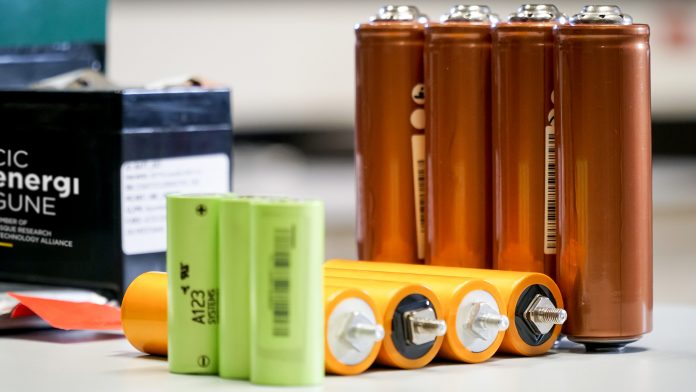Andrea Casas, Sustainability Expert at CIC energiGUNE, discusses the role of battery recycling in Europe’s sustainable future.
Battery recycling, as well as the design of batteries that are easily recyclable, will cease to be a ‘best practice’ in the storage industry and will become a mandatory requirement in Europe, expected by the end of 2023.
The proposal for the Battery Regulation, which is expected to be approved in the summer of 2023 and includes as one of the main measures the Battery Passport and the Green Deal Industrial Plan, including the Critical Raw Materials Act and the Net-Zero Industry Act, aims to establish single criteria at European level in terms of sustainability.
Within these criteria, one of the fundamental pillars is the recycling of batteries. Firstly, because it makes it possible to address the entire lifecycle of the cells or batteries. In addition, it will make it possible to reduce, for example, dependence on the supply of critical materials, which will contribute to the development and competitiveness of the European battery industry.
A regulation based on sustainability and competitiveness
The European commitment is very clear: ensuring the full lifecycle of the battery, from its production to its end of life. It is a comprehensive vision that, supported by this regulation, will lead all European Union (EU) member states to ensure compliance as of 2024, to guarantee the climate targets set by Europe for 2050. Its implementation will therefore guarantee the homogenisation not only of sustainable production or financing laws but also of the sustainability criteria applied to the battery sector.
One of the most relevant aspects of the new battery recycling regulation is undoubtedly the ‘Battery Passport’. The certainty of having a reliable and verifiable electronic registry of batteries manufactured and/or marketed in the EU positions Europe as a proactive continent in the development of a clean industry, with a clear model that could perhaps be scaled globally.
The Battery Passport is one of the first steps to ensure the circularity and, therefore, the sustainability of the battery sector, from the point of view of the carbon footprint, recycling efficiencies or minimum percentages of recycled critical materials content in newly manufactured batteries. Especially if we consider that, as of 1 January 2030, batteries will have to guarantee minimum percentages of recycled critical materials (12% for cobalt; 85% for lead; 4% for lithium; and 4% for nickel), or that, as of 1 July 2024, they will have to submit a carbon footprint declaration. The battery passport is therefore key to ensuring some of the most ambitious objectives of the new regulation in the battery recycling sector.
In the medium term, this monitoring system will be the basis not only for controlling the carbon footprint or the technical features of each device manufactured in Europe, but will be the gateway to the creation of an increasingly demanding system, in which the minimum percentages required will gradually become higher. In the end, this process will lead to the establishment of a categorisation system, in which the different types of batteries will be determined according to their carbon footprint. This will be a further element of control that can only be accessed if recycling is integrated into the battery industry’s business models as a key lifecycle strategy.
Further implications of the new regulations are related to minimising the social risks associated with the battery value chain, mainly in the procurement of critical materials. Finally, it is indisputable that, to ensure the sustainability of batteries, it is essential to address their three fundamental pillars: environmental, social and economic, as reflected in the various legislative initiatives approved in recent months.
Due to their relevance, compliance with these standards will be reinforced by exhaustive verification. This means that any battery manufactured or marketed in Europe, or those modified, will be compromised on all points by the specific requirements of its label.
Recyclability from the design
All of the above show that, for the battery industry to be able to achieve these objectives, the business models must be adapted and transformed in such a way that the recycling of these devices is addressed from the development of the concept. It is important not to forget that it is in the design where more than 80% of the impacts of a product are generated.
Therefore, ‘eco-design’ is emerging as an indispensable tool for complying with the requirements of the new regulations, supported by specific methodologies such as Life Cycle Assessment (LCA).
The strength of this type of methodology is its ability to identify, assess, and quantify the impact of a product or process on the environment, not only during its manufacture but also until its end of life. Therefore, the use of LCA will be an essential tool in the industrial activity of this sector.
Moreover, in this context, it cannot be overlooked that the commitment to battery recycling has an implicit component of self-protection of the European industry. Thanks to these initiatives, it is hoped not only to minimise Europe’s dependence on countries such as China, but also to position Europe in the race for the energy transition.
Another indispensable part of the new legislation is the ‘Critical Raw Materials Act’, which, as European Commission President Ursula von der Leyen recently pointed out, contributes to building a regulatory context aimed at facilitating a fast track to the energy transition.
In essence, this is precisely the main objective of the European legal infrastructure that is being built. A very clear way of confronting the actions of the rest of the major competitors – such as the US and its ‘Inflation Reduction Act’ – and to fight against the potential loss of companies and investments that could take advantage of tax advantages created when necessary in the fight for world leadership.

Consequently, it is not only a matter of Europe being able to speed up investments and industrial processes linked to the green economy, but also of consolidating and securing its business network and preventing the flight of talent and knowledge.
Regarding taxation, the ‘Net-Zero Industry Act’ has been designed to facilitate investor interest through incentives. However, the EU is aware that ‘positive’ initiatives such as this will not be enough. It is essential that it is combined with direct action, such as ensuring the supply of critical raw materials to local industry along clean technology lines. This is exactly where the Critical Raw Materials Act will have a lot to say.
Thanks to this standard, Europe will have control over the origin of imports, thus preventing excessive dependence on a few suppliers. In addition, it will make it possible to establish very clearly the categorisation of critical raw materials, establishing realistic minimums for each of them in terms of extraction, processing, battery recycling, and importation. The percentage established for possible imports, which in no case can be more than 65% from a single country outside the EU, is noteworthy for its high rate from the initial stages.

It also opens the door to support measures for the financing of strategic projects and the rapid management of administrative permits and lays the basis for the creation of an efficient circular economy for raw materials. In addition, concrete guidelines are established to reduce the risk of loss of supply, providing for the obligation for companies to carry out audits of their supply chain so that they have room to act in the event of unforeseen events.
A firm European commitment
In short, through these legal and regulatory initiatives, Europe’s commitment and effort to become the future benchmark for green technologies is clear. However, the fight between countries for the future of battery recycling still requires caution and attention to the response of the other competitors, especially the US and Asia. It is just as important to be alert to the actions of governments as it is to be alert to those of large companies and their investments, especially those with potential markets beyond Europe.
In conclusion, this new regulatory framework is designed to ensure the success of one of Europe’s great industrial bets for its future competitiveness. Therefore, it is essential to continue developing not only this regulation, but also all those scientific and technological advances that ensure the achievement of these objectives and their fulfilment as soon as possible, maintaining eco-design and recycling as fundamental pillars in the development of a competitive and strategic battery industry.
Please note, this article will also appear in the fourteenth edition of our quarterly publication.










